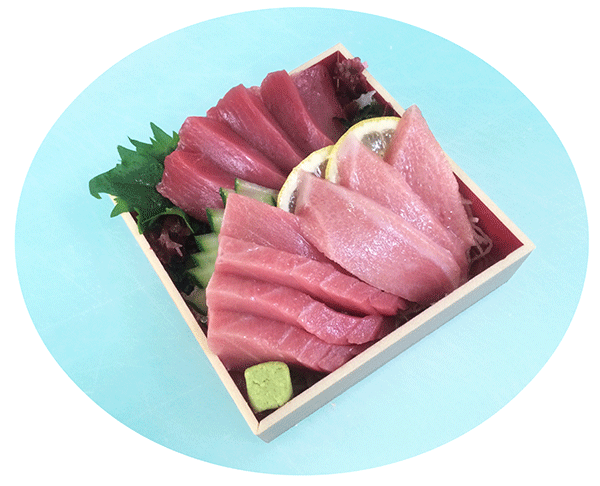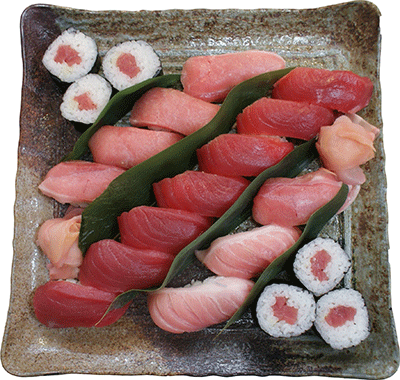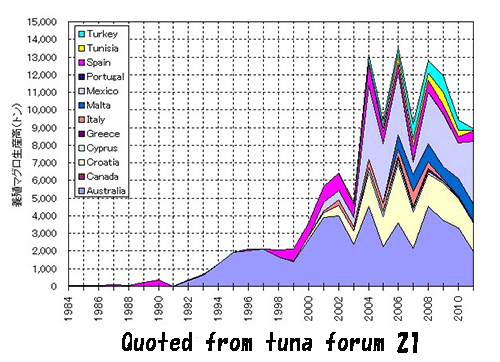Welcome to FISH FOOD TIMES


Mar. 2014 issue No.123

�@ �@
�@
Assorted sashimi of tuna fullness
This image is a assorted sashimi that uses only raw bluefin tuna.
I think people love tuna and do not come down the drool just by looking at this.
If this is a natural tuna, then there is a possibility that the price outrageous. However, this is because it uses a "bluefin tuna aquaculture", tuna only positive cost can also be calculated to 997 yen. Even the product of medium fatty tuna into a large fatty tuna, the selling price is the be possible to present a reasonable price fairly.
Made possible by a calculation that suppressed to cost of so much this, rate of aquaculture bluefin tuna raw is because have fallen Become a February of this year.
Mid-February rate of Tsukiji market, which is an indicator of the tuna market in Japan was cheap more than 10 percent from the previous year. It is considered by carrying amount of Mexico bluefin tuna aquaculture production of air transport was often than usual, especially, that it became a factor to drag on market price of bluefin tuna aquaculture Mexico this production.
Goes without saying of course, but those that market is one that changes from moment to moment. So when you can see, if people readers what has become tuna market then this article, and are not intended to be any guarantee that any readers.
At that point, the rate of domestic aquaculture bluefin tuna was 2,900 yen / kg of thing, 30 ~ 40kg 3,300 yen / kg in the 50-70 kg thing. And at the same time, rate of Mexico production aquaculture bluefin tuna had been 2,200 yen / kg next, 2,000 yen / kg in the next 30kg, price and very affordable at 60 kg thing.
But on the other hand, disruption of distribution network around the same time after the middle of February, suspended service of truck that successive under the influence of bad weather such as heavy snow has occurred tuna natural. The February 20 As a result, he became a super-high price of natural tuna of 126kg caught in Nagasaki Prefecture Iki that 27,000 yen / kg.
This is because of a natural raw tuna to more than 100kg, high prices of take because of its rarity can understand. But that price but also 10 times though it is the same raw bluefin tuna compared to the aquaculture of Mexico production is, because of a fish to be used as foods usually unlike your gratuity rate a spectacle of in the New Year's first auction, common sense still I do not understand from the very feeling.
Other tuna not only bluefin tuna also including the price of raw holds in the balance of supply and demand, but as one of the purpose of preventing it from are exposed to the unstable price fluctuations always such, that the tuna aquaculture but it should have appeared in this world.
However, all destination of aquaculture tuna because that may not be determined, he will be exposed to the evaluation of price listed on the fish market that something percent.
Top image "bluefin tuna sashimi Assorted fullness" is using the bluefin tuna aquaculture, but it's a combination Three slices of large Toro 10 g, 4 slices medium Toro 12 g, a 5-piece, red meat 15 g.
Yield rate is that it was 50% when you purchase at 3,000 yen / kg, 40 kg ones after removing belly and gills of domestic aquaculture bluefin tuna if, to commercialize this. And the different parts composition ratio is assumed to be a 60% red meat 15% Toro large, medium Toro and 25%. Then, it becomes 351 yen, 331 yen, 315 yen each of which can be calculated to be a total cost of 997 yen only tuna As described above.
In the case of cultured tuna, it is not such, the proportion of Toro the higher more often. In the same domestic aquaculture bluefin tuna, the different parts composition ratio, and 40% red meat, medium Toro 35%, and was 25% large Toro, it is possible to be converted 270 yen, 316 yen, 270 yen each, it is calculated that the total cost becomes 856 yen, 141 yen will be cheaper in one pack in this case.
What happens when if you use any of the things of 2,000 yen / kg of Mexico production rather than domestic production further. When different parts composition ratio and was the same as above if, it becomes 180 yen each, ¥ 212, ¥ 180, Total cost is becoming calculations down to "572 yen" what.
It may be said of 3,000 yen / kg purchase cost is because of such to 2,000 yen / kg, that it might be put out the result by a simple division is total cost, but this is made ??costing of different parts ahead a than become easy because are, it does not come out so easily the original calculation has not made??.
However, different parts costing of tuna, which has been described above is of could be calculated by simply driven into the PC number that has changed in the purchase cost in practice.
Is not only the calculation of the yield rate, costing of this tuna, are using a number of its own called "converted cost variables" in order to convert by the variable "value of different parts."
This "converted cost variables"Because those of characteristics that in light of various factors such as freshness, season, and needs high and low, is arbitrarily changed, and believed to be the change intentionally rather than constant it want.
Calculation method of tuna to take advantage of this "converted cost variables" are those that are termed "Higuchi equation tuna different parts cost accounting", how to evaluate the difference in value by site-large Toro, and medium Toro, further and are aimed at how much easily derived, the cost per piece of sushi and sashimi.

For example, this sushi Assorted is an example of a "bluefin tuna sushi fullness assorted", but they are commercialized using the raw bluefin tuna natural rather than aquaculture.
In this case, the part of red meat, how the reader would have to calculate the cost, the part of the divided body that was used to Tuna roll and even medium Toro, and large Toro.
In these days, it might be said that you purchase at the price that separately, the portions is divided into such medium Toro and red meat from the beginning because there are many, such a calculation that's simple, but the purchase in loin the abdominal segment of bluefin tuna if as was, How will you calculate the value of each.
If you dismantle it buys round one fish rather than the loin Furthermore, it seems that there is no more necessarily people that can be easily calculated within the instant these, but they are presented here "Higuchi method" really easy and he can compute.
Unfortunately, since this is also one of the know-how of our company, you can not afford to publish this detail in this paper surface, but if people can use Excel on a PC, simply by simply type in the number it is a very convenient way to deduce the cost of different parts.
Please contact us at "info @ fish food times" if you are interested.
Well, in FISH FOOD TIMES,such as "seared sashimi thin cheek meat tuna" in (�� 92) January 2010, and "tuna sushi fullness assorted" in (�� 97)August 2006, "dogtooth tuna flat sashimi" in (�� 58)October 2008, "college tuna" in (�� 46)October 2007, many times about things that are related to the tuna from the viewpoint of various so far I've been touched.
And in this article, speaking of tuna so far been distributed in Japan, "frozen tuna" was a prerequisite to a bygone era as the base this time, but the presence of "raw tuna" is becoming increasingly more and more all over the country now I have been focusing attention on that.
Cut into different parts in the band saw, rather than that of frozen tuna to be delivered in styrofoam boxes, such as costing and tuna thing about the rate of tuna that has been mentioned from the opening paragraph, would be to be related to the raw tuna all.
I think when you are going to eat the tuna, if forced to make a choice of either or raw or frozen, people who choose a more raw without being at a loss maybe a lot, but this is at the limit of what to say frozen fish This is because there is the thing which "is watery, such as omission of taste" that can not be avoided in frozen tuna.
Refrigeration technology, which is backed by great technology called "CAS tuna" as state-of-the-art of the times are present, although the tuna raw good freshness, it's no choice but to concede one step in that taste still even it is in fact .
Also, going out to the open ocean far from Japan pelagic tuna vessels of Japan over a long number of days, it was back to bring to Japan where they harvested the tuna in the old days. But from the fact that as the trend of the times, and now, for example, fishing vessels of countries of the South Seas is caught in the power of their own in the field, to carry to Japan by air raw it has also become possible, and pelagic tuna vessels positioning of frozen tuna to catch is you're no longer prove presence as it used to.
The left graph below, such as yellowfin tuna that live in relatively warm regions of the earth, shows that it has come to the catch of local people to compete for these. And On the other hand, that the landings has decreased more and more are represented, such as high-value bluefin tuna that live in relatively cold region in the graph on the right.

Now, as will be inversely proportional to the catch reduction of southern bluefin tuna and bluefin natural, aquaculture tuna has come to be carried out throughout the world are shown in the graph below, these remain imported raw be is he like has increased.

It seems almost certain that the percentage of the total of frozen tuna still more doing this has become much less. Giant frozen tuna industry's Toyoreizo have the power enough to affect the market price of frozen tuna Mitsubishi Corporation lineage as a typical example, focusing on the handling of raw tuna, tuna farming business more recently but is to because of that it has expand into, that it is possible circumstances of the neighborhood is glimpse.
Recently, not only the aquaculture of southern bluefin tuna and bluefin tuna, bigeye tuna, yellowfin tuna has also come to be regarded as a target aquaculture (capture aquaculture), that the tuna eat raw farmed fish in the same way as sea bream and yellowtail era to become a normally he as come to there.
In Japan, the region Nansei Islands and southern Kyushu, Okinawa natural tuna is caught well in the nearby sea, were usually to eat a raw tuna for a long time, but this is a relatively inexpensive such as albacore tuna natural that yellowfin tuna, juvenile of those is called Sibi more a subject, and that usually eat in an expensive aquaculture bluefin tuna was not impossible in the first place.
However, your site, you might want to consider is not only region in the south of this kind of Japan, and that came into the era of "tuna raw with a focus on aquaculture" is being continue to spread across the country from now on.
And that high cost food bill piling up, and very difficulty to ensure the juvenile to farming, hurdle that must be exceeded its seems high, but frozen tuna by deep-sea fishing is the trend of the times farmed tuna as a result, it is considered that it is in the forced reduction environment, and shifts mainstay to raw tuna definitely.
How to do with it future tuna is a popular number one immovable for the Japanese, people involved more or less there will should take serious about this.

Date of updating |
Mar.1, 2014 |
Food commerce contribution sentence
| Food commerce contribution sentence (foregoing volume) |
An opinion and the communication are to info@fish food times